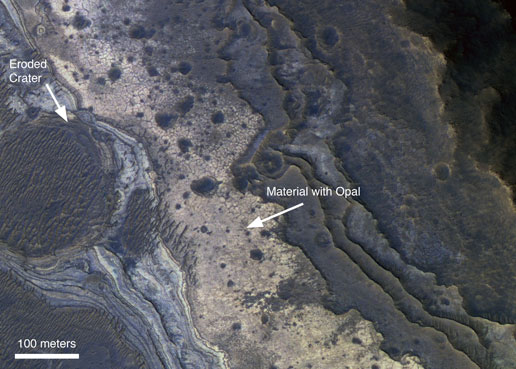[/caption]
The discovery of a water-based mineral on Mars by the spectrometer on board the Mars Reconnaissance Orbiter suggests liquid water remained on the planet’s surface a billion years later than was previously thought, and it likely played an important role in shaping the planet’s surface and possibly hosting life. Hydrated silica, commonly known as opal, has been found across large region of Mars. “This is an exciting discovery because it extends the time range for liquid water on Mars, and the places where it might have supported life,” said Scott Murchie, the principal investigator for the Compact Reconnaissance Imaging Spectrometer for Mars (CRISM) at the Johns Hopkins University Applied Physics Laboratory in Laurel, Md. “The identification of opaline silica tells us that water may have existed as recently as 2 billion years ago.”
The water-based mineral deposits are telltale signs of where and when water was present on ancient Mars. On Earth, opals consist of at least 3-10% water, and Precious Opal, the variety used most often in jewelry, have pockets of spheres that diffract light at various wavelengths, creating colors and a beautiful, if not valuable look. Opal is found in Australia, England and the western US.
On Mars, the hydrated silica has been found around Mars “Grand Canyon”. “We see numerous outcrops of opal-like minerals, commonly in thin layers extending for very long distances around the rim of Valles Marineris and sometimes within the canyon system itself,” said Ralph Milliken of NASA’s Jet Propulsion Laboratory in Pasadena, Calif.
Until now, only two major groups of hydrated minerals, phyllosilicates and hydrated sulfates, had been observed by spacecraft orbiting Mars. Clay-like phyllosilicates formed more than 3.5 billion years ago where igneous rock came into long-term contact with water. During the next several hundred million years, until approximately 3 billion years ago, hydrated sulfates formed from the evaporation of salty and sometimes acidic water.
The newly discovered opaline silicates are the youngest of the three types of hydrated minerals. They formed where liquid water altered materials created by volcanic activity or meteorite impact on the Martian surface. One such location noted by scientists is the large Martian canyon system called Valles Marineris.
These types of minerals were also recently found in Gusev Crater by NASA’s Mars rover Spirit, are widespread and occur in relatively young terrains.
In some locations, the orbiter’s spectrometer observed opaline silica with iron sulfate minerals, either in or around dry river channels. This indicates the acidic water remained on the Martian surface for an extended period of time. Milliken and his colleagues believe that in these areas, low-temperature acidic water was involved in forming the opal. In areas where there is no clear evidence that the water was acidic, deposits may have formed under a wide range of conditions.
“What’s important is that the longer liquid water existed on Mars, the longer the window during which Mars may have supported life,” says Milliken. “The opaline silica deposits would be good places to explore to assess the potential for habitability on Mars, especially in these younger terrains.”
Source: JPL


Can’t wait for the first De Beers sample-return mission to Mars!
Seriously though, this is promissing for future commercial interests in Mars exploration. Imagine what the rich and famous would pay for a Martian opal necklace!
Great, now NASA will have big budget backers from private investors! 😀
Well, the largest chunk of opal on Earth, according to Wikipedia, is the fist-sized “Halley’s Comet Opal”, discovered in 1986. It’s worth $1.2 million. So all we have to do is haul back a few thousand fist-sized opals, and the mission is paid for!
Unless, of course, they don’t sell for a million bucks a piece any more, once you have a few thousand in your garage.
Ah, but remember, you’re talking about a few thousand fist sized lumps of /martian/ opal, not terrestrial opal. I imagine they’d be worth substantially more then a million bucks, because those would be the only pieces of martian opal we have on this planet (thus making it a unique commodity).
RobertB Says:
October 28th, 2008 at 3:47 pm
Trippy Says:
October 28th, 2008 at 4:31 pm
Ahh – the many subtle economic considerations of Martian sample return!
Now all we need to do is find that oil… gotta be around this place somewhere…
Seriously though, I wonder what other materials will be on there.
I would laugh (and cry) if they did somehow find oil on there somewhere.
Why ruin one planet when you can do 2 at the same time!
Well actually, for Mars, oil use would be a good thing.
Drill, baby, drill !!!
If there was Oil surely there would have been life???
drilling in the Martian wildlife sanctuary anyone…?
Let the rape of another planet commence!
It’s a bit silly to start talking about “raping” a planet for it’s resources when there’s nothing alive there that would have any use for those resources anyway.
By this logic we shouldn’t touch asteroids for their minerals either… Use your head people.
Hear, Hear, Dutch!
There is a reason we have brains, it’s so we can go forth and find uses for what we need. Hippies that are worried about “raping a planet” have never produced anything worthwhile anyway. It doesn’t seem to stop them from driving their Prius’s and surfing on their Macs.